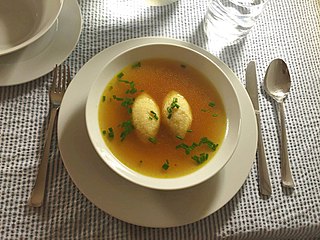
Dessert is a course that concludes a meal. The course consists of sweet foods, such as cake, biscuit, ice cream and possibly a beverage such as dessert wine and liqueur. Some cultures sweeten foods that are more commonly savory to create desserts. In some parts of the world there is no tradition of a dessert course to conclude a meal.

Confectionery is the art of making confections, or sweet foods. Confections are items that are rich in sugar and carbohydrates although exact definitions are difficult. In general, however, confections are divided into two broad and somewhat overlapping categories: bakers' confections and sugar confections.

Pastry refers to a variety of doughs, as well as the sweet and savoury baked goods made from them. These goods are often called pastries as a synecdoche, and the dough may be accordingly called pastry dough for clarity. Sweetened pastries are often described as bakers' confectionery. Common pastry dishes include pies, tarts, quiches, croissants, and pasties.

A Danish pastry is a multilayered, laminated sweet pastry in the viennoiserie tradition. It is thought that some bakery techniques were brought to Denmark by Austrian bakers, and originated the name of this pastry. The Danish recipe is however different from the Viennese one and has since developed into a Danish specialty.

Austrian cuisine consists of many different local or regional cuisines. In addition to Viennese cuisine, which is predominantly based on the cooking traditions of the Habsburg Empire, there are independent regional traditions in all the states of Austria.

Kuchen, the German word for cake, is used in other languages as the name for several different types of savory or sweet desserts, pastries, and gateaux. Most Kuchen have eggs, flour and sugar as common ingredients while also, but not always, including some fat. In the Germanosphere it is a common tradition to invite friends over to one's house or to a cafe between noon and evening to drink coffee and eat Kuchen.

Demel is a famous pastry shop and chocolaterie established in 1786 in Vienna, Austria. The company bears the title of a Purveyor to the Imperial and Royal Court up to today.

A torte is a rich, usually multilayered, cake that is filled with whipped cream, buttercreams, mousses, jams, or fruit.

Esterházy torta is a Hungarian cake (torte) named after Prince Paul III Anton Esterházy de Galántha (1786–1866), a member of the Esterházy dynasty and diplomat of the Austrian Empire. It was invented by Budapest confectioners in the late 19th century and soon became one of the most famous cakes in the lands of the Austro-Hungarian Monarchy.

Pasta frola or pasta frolla is a type of sweet tart common to Italy, Argentina, Paraguay, Uruguay, Egypt and Greece. It is a covered, jam-filled shortcrust pastry dish principally made from flour, sugar and egg. Common fillings include quince cheese, dulce de batata, dulce de leche, guava, or strawberry jam. The covering of the tart is a thin-striped lattice which displays the filling beneath in rhomboidal or square sections. Pastafrola is most usually oven-baked in a circular shape. Most of the Greek versions of this dish are filled with sweet jam: it is considered a morning dessert.

A pasticciotto is a type of filled Italian pastry. Depending on the region, they are traditionally filled with either ricotta cheese or egg custard.

Wähe is a baked dish typical of Swiss and Alemannic (German) cuisine. A wähe consists of a casing and a topping of a custard enveloping either fruit, vegetables or cheese. The custard and fruits or vegetables are baked together. The preparation is thus very similar to that of the French quiche or tarte.
The fourth season of The Great Canadian Baking Show premiered on CBC Television on February 14, 2021. As with previous seasons, ten amateur bakers will compete over eight weeks of challenges, vying for the title. The season marked the debut of Ann Pornel and Alan Shane Lewis as hosts, who replaced Carolyn Taylor and Aurora Browne. Bruno Feldeisen and Kyla Kennaley returned for their fourth and second seasons respectively as judges.
The first season of Top Chef: Just Desserts was broadcast on Bravo. It featured 12 pastry chefs fighting to win the title of Top Chef.














